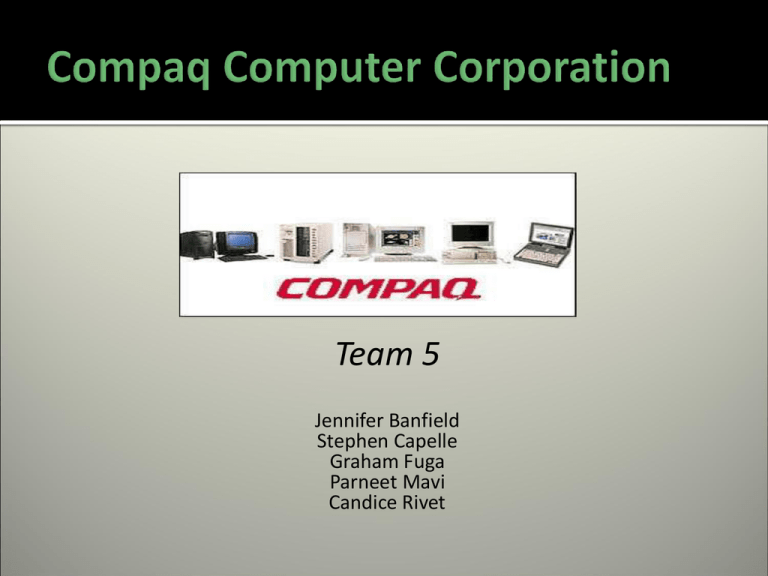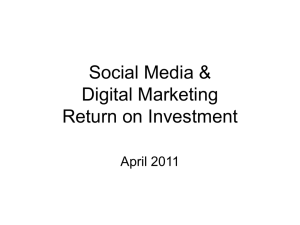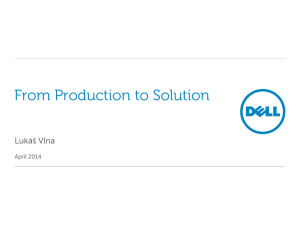Compaq Computer Corporation
advertisement

Team 5 Jennifer Banfield Stephen Capelle Graham Fuga Parneet Mavi Candice Rivet In the 1990’s, Compaq was a global leader in PCs with a strong position in the PC server business and in direct competition with IBM, HP and Dell. By 1995, they held the highest global PC market share at over 10%. By 1998, Compaq was the second largest computer company in the world. Compaq was organized into three large business units: Enterprise Solutions and Services Commercial Personal Computing Consumer The majority of revenues coming from Enterprise Solutions and Services Strategy: Enterprise computing Tactics: Acquisition –DEC, Tandem Operations Model: Off the shelf models Dealer channel Compaq's market position weakened Losing market share Failure to resolve the indirect distribution challenges Particularly in commercial personal computing segment (exhibit 11) Strong Competition The Dell Direct Model Problems with Compaq’s strategy Three core business processes – people, strategy and operations are not linked Since 1995 Compaq has been moving from a PC maker to a full-service IT company Key elements of this strategy: DEC and Tandem acquisitions Its core PC business began to drift New technologies to market faster Low-cost of consumer PCs Intense price competition DEC &Tandem added more layers of complexity Large and complex IT systems needed to support such a centralized structure Sell through a variety of channels Large, medium business & Government through dealers, value-added resellers and system integrators Small business & home customers through dealers and consumer channels Re-seller margins on name-brand desktop PCs had been shrinking over the years E-Commerce is related to the organizational problem Customers want to directly deal with the manufacturer Lower costs Increased customer support Resellers do not want direct dealing They must lower prices They must offer more support and services E-Commerce software available for purchase E-Commerce software can be developed internally, allowing greater customization, flexibility and customer satisfaction Business to Business (B2B) Advantages Already using this method (dealing with shipping companies, resellers, parts manufacturers) Larger market Savings in costs and efficiencies 24/7 operation Bid opportunities Business to Business (B2B) Disadvantages Costs of networks Privacy issues Legal boundaries Losses from increased competition Keeping up with technological changes Business to Consumer (B2C) Advantages The way Dell became so large so fast Compaq wanted to use Dell’s ideas Lower prices 24/7 operation Easy on-line technical support Easy to track market segments and customers Flexible Easy to expand and sell anywhere Business to Consumer (B2C) Disadvantages Customers need access to the internet to place orders Customers are scared of internet monetary transactions Worry about privacy Worry about returns/exchanges Do Nothing Focus solely on Indirect and Partner Direct (VAR’s) Distribution channels Switch to a Direct Distribution Model Do Nothing Pros: ▪ No investment needed Cons: ▪ No resolution to “Customer Confusion” Strategy ▪ Bitter relationships with resellers ▪ Loss of referrals to other manufacturers Focus solely on Indirect and Partner Direct (VAR’s) Distribution channels Pros: ▪ Utilization of existing infrastructure Cons: ▪ Lose out on ‘direct option’ customers ▪ Inventory costs ▪ Lack of responsiveness Switch to a Direct Distribution Model Pros: ▪ Provide products at lower cost to customer ▪ Potential increase in sales ▪ Increased responsiveness ▪ Increased ability to forecast demand Cons: ▪ Requires significant changes in infrastructure as well as strategy ▪ Sophisticated ‘customer-oriented’ IT infrastructure ▪ Close working relationships with suppliers ▪ Direct competition with Dell that has expertise in the direct distribution model ▪ 85% of sales in the Commercial Personal Computing Channel, still generated by traditional indirect channel Hybrid Model Components 1. Retain but re-engineer the indirect retail channel (B2B). 2. Reduce the role of resellers. 3. Develop a stronger direct distribution channel (B2C). 1. Retain but redefine the current Indirect Channel Retain: The indirect channel generated 85% of the sales for Compaq, compared to the industry average of 70% (Exhibit 12). The company still had an edge over competitors in this channel. Retain but re-engineer the current Indirect Channel Re-engineer the process so that the channel fits the role of being an extension of the company’s sales force into those markets that it can't cover through a cost-effective model adding value-added services downstream. 2. Eliminate the role of reseller in commercial personal computing segment Reduce the confusion in the ‘customer choice’ strategy. Savings on commissions could be transferred to the customer via lower prices. Resources could be diverted to strengthen the organization’s IT capabilities. 3. Develop a stronger direct distribution channel The direct channel (B2C) would be modeled along the Dell direct business model, that had proven to be the key success factor for Dell. Compaq had already begun to offer enhanced selling and support services to its Prosignia customers and these capabilities could be developed further. In 2001, Compaq merged with Hewlett-Packard and HP subsequently laid off thousands of former Compaq employees. Although the merger initially made it the number one PC maker, it soon lost the lead and further market share to Dell. In late 2005, thanks to new leadership and slumping sales at Dell, HP retook the lead in the PC sales race and remains at global sales leader to date. In 2008, HP dropped the "Compaq" name from its "HP Compaq" business notebooks, leaving the Compaq name for HP's entry-level consumer platforms. Compaq’s Main Webpage – first tab highlighted is Learn & Shop Compaq’s Main Webpage – hovering over any section shows the same menu Shop the Compaq Store – only Consumer products are shown HP Store – clicking on certain links from the Compaq page redirects to the HP Store Find a Retailer – direct links to retailers’ Compaq products page Best Buy’s Compaq page – able to purchase Compaq products online from retailers Compaq’s Support Webpage – easy to use online technical support In 2002, Dell started opening kiosk locations in shopping malls across the U.S. and in 2005, they expanded their kiosk initiative worldwide. In 2006, they opened their first full store in Dallas, TX. In 2008, Dell closed all 140 mall kiosks in the U.S. to focus on expansion into retail stores such as Wal-Mart. The “Dell Partner Direct” Program was announced in 2007 and consisted of utilizing Value-Added Resellers as an outlet to increase sales and regain lost market share. To become and stay an industry leader, you must realize profitable business and IT strategies and not be afraid to try them, or someone else will. In this changing world, people will always flock to a faster, more convenient, cheaper channel to do business; this should be at the fore-front of any good business strategy. We should be looking to IT for innovative time saving business strategies. IT is so widely accessible nowadays that it should never hinder a company’s success.











